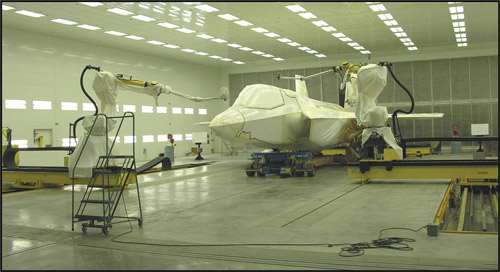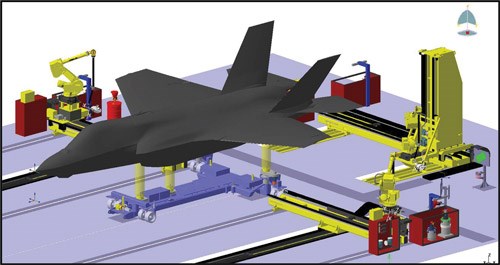Published
F-35 Gets New Paint System
Robots now control all the moves.
Contributor
Lockheed Martin has migrated its F-35 Lightning II robotic painting work cells to Dassault Systèmes’ (Auburn Hills, MI) Delmia Robotics.
The move allows Lockheed Martin to have a common computer interface across its design authoring software and digital manufacturing solutions, both of which also come from Delmia.
“Lockheed Martin was quick to understand the benefits to be gained by having all engineers working with the same user interface paradigms,” says Steve Milliren, Delmia’s executive account manager for the aerospace industry.
Lockheed Martin uses computer simulations to verify that the robots will reach all the painting positions while avoiding any collisions. The company says automating the paint and coatings process provides significant time savings, as well as better process control.
The system use two different automated paint cells, both configured on moving rails. A three-robot cell is dedicated to painting the aircraft exterior, and a two-robot cell is configured to handle a variety of F-35 components. Both the physical cell and the robot programming have been designed so that the company can paint different mixes of components at different times.
Additionally, the Delmia software allows Lockheed Martin to monitor the thickness of coatings—a critical factor in ensuring that aircraft meet design requirements—through a query option at any point in the application.
Enhancements within Delmia’s Cenit Fastsurf software make it easier to modify existing robot programs for significant time gains. Previous solutions required extensive rework any time a component design changed, but adapting to a part change can be as simple as plugging a new parameter in the setup.
“Working with a visionary company such as Lockheed Martin has allowed Cenit to verify the value of our Fastsurf solution,” says Cenit account manager Niall Cullen. “Their in-depth experience in robotic OLP was key in shaping a production-hardened solution with aerospace accuracy.”
In addition to the robotics, Lockheed Martin also uses Dassault Systemes’ Virtual Ergonomics and DPM Assembly solutions.
To learn more about Dassault Systèmes, please call 248-267-9696, or visit 3DS.com.
RELATED CONTENT
-
Is Your Electroplating Waste Hazardous?
Some that bears precious metals is, and there are a host of regulations to consider when recycling.
-
Curing Oven Basics
Simply heating up the substrate does not cure the coating. There are many variables to consider when choosing the best cure oven for your application...
-
Understanding Paint Atomization
BASF coatings development expert Tim December explains how paint atomization works for both pneumatic spray applicators and high-speed rotary bell applicators.


















